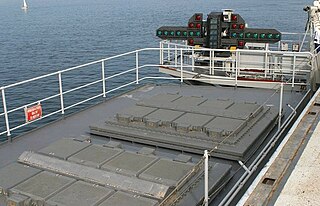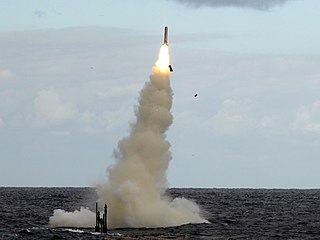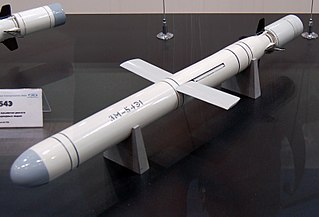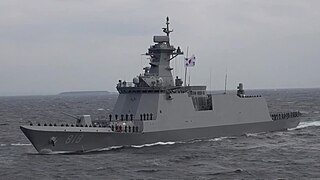
A cruise missile is an unmanned self-propelled guided vehicle that sustains flight through aerodynamic lift for most of its flight path and whose primary mission is to place an ordnance or special payload on a target. Cruise missiles are designed to deliver a large warhead over long distances with high precision. Modern cruise missiles are capable of traveling at high subsonic, supersonic, or hypersonic speeds, are self-navigating, and are able to fly on a non-ballistic, extremely low-altitude trajectory.

A cruise missile submarine is a submarine that carries and launches cruise missiles as its primary armament. Missiles greatly enhance a warship's ability to attack surface combatants and strike land targets; although torpedoes are a more discrete option for submerged submarines, missiles give a much longer stand-off range, shorter time to impact the target, as well as the ability to engage multiple targets on different headings at the same time. Many cruise missile submarines retain the capability to deploy nuclear warheads on their missiles, but they are considered distinct from ballistic missile submarines due to the substantial differences between the two weapons systems' flight characteristics; cruise missiles fly aerodynamically using flight surfaces like wings or fins, while a ballistic missile uses its engine power alone as it may exit the atmosphere.

The Sylver is a vertical launching system (VLS) designed by DCNS and introduced in 2001.

A vertical launching system (VLS) is an advanced system for holding and firing missiles on mobile naval platforms, such as surface ships and submarines. Each vertical launch system consists of a number of cells, which can hold one or more missiles ready for firing. Typically, each cell can hold a number of different types of missiles, allowing the ship flexibility to load the best set for any given mission. Further, when new missiles are developed, they are typically fitted to the existing vertical launch systems of that nation, allowing existing ships to use new types of missiles without expensive rework. When the command is given, the missile flies straight up far enough to clear the cell and the ship, then turns onto the desired course.

A submarine-launched cruise missile (SLCM) is a cruise missile that is launched from a submarine. Current versions are typically standoff weapons known as land-attack cruise missiles (LACMs), which are used to attack predetermined land targets with conventional or nuclear payloads. Anti-ship cruise missiles (ASCMs) are also used, and some submarine-launched cruise missiles have variants for both functions.

The Sejong the Great-class destroyers, also known as KDX-III, are three guided-missile destroyers of the Republic of Korea Navy (ROKN).

Hyunmoo is a series of cruise and ballistic missiles developed by Hanwha Aerospace in the defense industry of South Korea. They are also referred to by the press as Chunmoo.

The Novator Kalibr, also referred to as 3M54-1 Kalibr, 3M14 Biryuza, is a family of Russian cruise missiles developed by NPO Novator (OKB-8). It first saw service in 1994. There are ship-launched, submarine-launched and air-launched versions of the missile, and variants for anti-ship, anti-submarine and land attack use. Some versions have a second propulsion stage that initiates a supersonic sprint in the terminal approach to the target, reducing the time that air defense systems have to react, while subsonic versions have greater range than the supersonic variants. The missile can carry a warhead weighing up to 500 kilograms (1,100 lb) of explosive or a thermonuclear warhead.

The Hyunmoo-3 is a cruise missile fielded by the South Korean military designed by Agency for Defense Development (ADD). The name Hyunmoo comes from a mythical beast described as the "Guardian of the Northern Sky", perhaps hinting North Korea.

The SSM-700K C-Star (Haeseong) is a ship-launched sea-skimming surface-to-surface anti-ship cruise missile developed by the South Korean Agency for Defense Development (ADD), LIG Nex1 and the Republic of Korea Navy in 2003. The missiles are deployed on KDX-II and KDX-III destroyers as of 2006, each carrying 8 and 16 of the missiles respectively, and on Ulsan-class frigates.

The Mark 41 Vertical Launching System is a shipborne missile canister launching system which provides a rapid-fire launch capability against hostile threats. The Vertical Launch System (VLS) concept was derived from work on the Aegis Combat System.
The YJ-18 is a Chinese family of anti-ship and land attack cruise missiles.

ROKS Daegu (FFG-818) is the lead ship of the Daegu-class frigate in the Republic of Korea Navy. She is named after the city, Daegu.

The Daegu-class frigate is a class of guided missile frigates of the Republic of Korea Navy (ROKN). The Daegu class is based on the preceding Incheon class, and has otherwise been referred to as the Incheon class batch II, or FFG-II. Eight Daegu-class ships have been commissioned, with the final goal of 20–22 frigates, of all types, in the ROKN. The Daegu-class frigates were built by Daewoo Shipbuilding & Marine Engineering (DSME) and Hyundai Heavy Industries.

The KSS-III, often called Dosan Ahn Changho-class is a series of diesel-electric attack submarines currently being built for the Republic of Korea Navy (ROKN), jointly by Hanwha Ocean and HD Hyundai Heavy Industries (HHI). The KSS-III is the final phase of the Korean Attack Submarine program, a three-phased program to build 27 attack submarines for the ROKN, between 1994–2029.
GJB 5860-2006 is a Chinese military technical standard describing a vertical launching system (VLS) for all types of missiles aboard surface combatants.

ROKS Gyeongnam (FFG-819) is the second ship of the Daegu-class frigate in the Republic of Korea Navy. She is named after the place, Gyeongnam.
ROKS Seoul (FFG-821) is the third ship of the Daegu-class frigate in the Republic of Korea Navy. She is named after the capital, Seoul.
ROKS Donghae (FFG-822) is the fourth ship of the Daegu-class frigate in the Republic of Korea Navy. She is named after the city, Donghae.
ROKS Daejeon (FFG-823) is the fifth ship of the Daegu-class frigate in the Republic of Korea Navy. She is named after the city, Daejeon.














